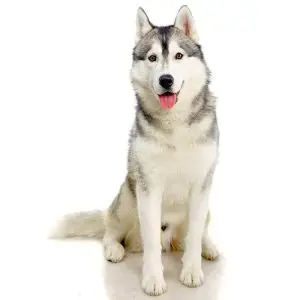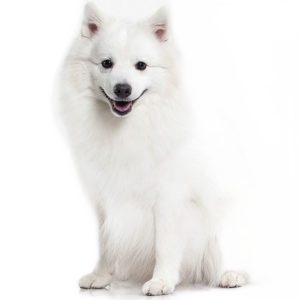Keeshond
Playful, loving, easy-going
This breed has a medium probability of having health issues in its lifetime, hence it is one of the more affordable breeds to insure.

Is this breed right for you?
Try our breed selector quiz to find out your best matching breed!
Insuring a Keeshond?
Get our award-winning Nose-to-Tail Cover with up to $30k annual benefit limit, up to 90% of eligible vet bills back, and no sub-limits.
Get a quick quoteBreed Overview
The Keeshond, or ‘Kees’ to those on more affectionate terms with the breed, is a beautiful, eye-catching dog that is most recognisable by its long, heavy coat. Its other stand-out feature are its almond-shaped brown eyes, which are rimmed in black and highlighted by circular black markings that surround the eyes, creating the illusion of “spectacles”.
As a Spitz breed, the Keeshond is characterised by a wolf-like appearance, although many think this magnificent dog looks more like a cross between a fox and a wolf with its alert, intelligent, fox-like expression, smallish head and small, pointy ears. With a sturdy, compact body, the adult keeshond is a medium size dog that weighs from 14 to 18 kg and reaches a height of 43 to 46 cm.
The Keeshond’s head is covered with smooth, short hair that lengthens and thickens over the neck and shoulders, giving the appearance of an impressive, lion-like mane, particularly in the male dog. It has a long, feathery tail which it carries high and tightly curled over its back, where it lies flat against the body.
The thick double coat comprises a long, straight, harsh outer coat of silver-grey with black tinted ends and a thick, down-like undercoat which is pale grey or cream. Surprisingly, this striking coat is fairly easy to maintain. It does not tangle, is odourless when dry and the outer coat sheds dirt as it dries after a wet activity. In fact, it only needs a quick brush a couple of times per week, except when it sheds heavily – in autumn and spring – when extra grooming is required. The Keeshond is a natural breed and very little trimming is required, while baths should be given only when necessary.
The Keeshond is lively, intelligent, alert and energetic, requiring moderate daily exercise that provides both physical and mental stimulation. One or two brisk daily walks, a free run or playing fetch with a family member within a fenced backyard will provide these dogs with all the exercise they need to stay healthy, happy and out of trouble (without appropriate exercise, Keeshonds can become unruly and rip things apart inside of the house). However, exercise shouldn’t be boring and repetitive; spontaneity is essential from time to time and he will be ready and raring to hop into the car or to go to the park, shops or wherever your fancy takes you. At the end of a busy day, he will be glad to climb up on the sofa to relax or snuggle with you while you read or watch TV.
Although he has an independent streak, the Kees can be an incredibly obedient. In fact, many Keeshonds excel at obedience, as well as agility, performing and scoring highly in competitive arenas. Keeshonds have also distinguished themselves as therapy dogs, visiting sick children and adults in hospitals and rehabilitation facilities.
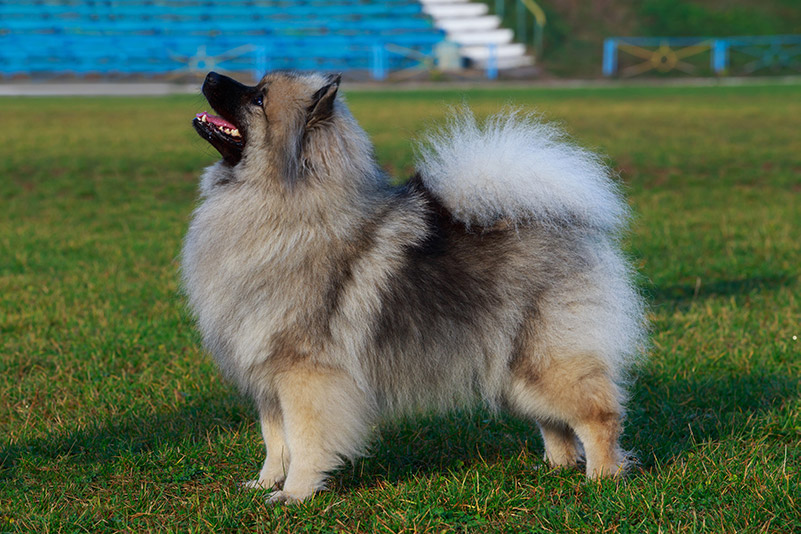
Personality and Temperament
Not just beautiful to look at, the Keeshond is also known for its beautiful nature. It has lots of personality and spunk, is lively and energetic, and above all, is an affectionate, good-natured and loyal companion. It is very sociable breed that enjoys interacting with friendly people and other animals.
The Keeshond loves giving and receiving affection and attention and thrives as a companion dog for a large family. Keeshonds are great with children of all ages, making ideal playmates as they can join in their games, however rowdy and rough, with no fear of getting out of hand. When raised with the kids from puppyhood, they love snuggling up and relaxing with them on the couch, and the kids love the warm, furry blanket that their Keeshond provides!
Keeshonds will gladly accept strangers as friends once they have been properly introduced, sometimes a bit overwhelmingly. Despite their smallish size they are brave, making excellent watchdogs who will defend their families without concern for their own well-being. They will bark when an intruder approaches the house but unless they feel that their family is threatened, will most likely welcome them, lick them and beg for food once they enter. Which leads to their other pastime, eating – they enjoy food as much as any gourmand! On the downside, they are inclined to beg and tend to eat and eat until you have to stop them. They can also be barkers, easily crossing the line into nuisance.
Keeshonds have a sense of humour and an enjoyment for life which is delightful. They are naturally happy dogs who will smile every day if you just spend time with them, as they do need daily contact with their owners and lots of activity to remain happy. Therefore, they are not a suitable choice for those who want a dog that lives happily alone in a kennel or backyard. However, Keeshonds will adapt to many different environments. Historically they have lived in homes ranging from farms with lots of space to run, to barges with little room to move around.
Because of their high intelligence, most problems are likely to arise from the Keeshond inventing his own activities – usually destructive ones, like digging and chewing. They are best suited to an owner who is caring and gentle and treats them with patience, kindness and consistency. While most dogs need a structured environment, it’s especially necessary with a Keeshond.
They are very smart, adaptable and highly trainable; however, while Keeshonds are fast learners and are motivated to please their trainer, they can quickly become bored with repetitive training. Training sessions are most successful when conducted with love and kindness and result in the dog getting positive reinforcement from edible rewards. Harsh words and treatment will get you nowhere with a Kees! It is important to start training him as a puppy between 10 and 14 weeks with socialisation and puppy training classes. Without training he will learn plenty, but not necessarily what you had in mind!
Common Keeshond Diseases & Conditions
Symptoms, diagnosis and treatment
The typical Keeshond is happy, healthy and not prone to injury or disease, but the following conditions occasionally occur in the breed:
- Joint problems: Hip dysplasia occurs when the ball of the hip joint does not develop normally and fails to fit snugly into the hip socket, causing stiffness and inflammation of the joints.
Elbow dysplasia occurs when the elbow joint does not develop normally, which can result in arthritis and stiffness in the joints when he gets older.
A luxating patella is a loose or unstable kneecap, i.e. one that slips out of place. This condition can lead to other knee injuries, arthritis and pain. - Eye problems: Progressive Retinal Atrophy (PRA) includes several inherited diseases that lead to degeneration of retinal photoreceptor cells (i.e. the rods and cones), typically leading to blindness. PRA worsens over time, with affected animals initially experiencing night blindness as the rods are affected first. The condition progresses to failed daytime vision.
Cataracts are a change in the structure of the lens of the eye which leads to cloudiness and blurred vision, eventually leading to blindness if left untreated. Congenital cataracts can appear early (4 to 5 months old) or late (around 6 years old); in many cases they can be treated surgically. - Epilepsy: Epilepsy is a general term for neurological disorders that bring on sudden and repeated seizures. A seizure, also known as a ‘fit’, is an abnormal, uncontrolled burst of electrical activity in the brain. Epilepsy is characterised by a pattern of repeated seizures over time, often occurring during rest or sleep, either at night or early morning. Typically, the dog stiffens and falls on its side, where it will salivate, chew at its mouth, paddle its limbs, release its bladder or bowels and/or cry out. Most cases of epilepsy in dogs cannot be cured. The aim of treatment is to eliminate seizures without causing intolerable side effects.
- Hypothyroidism: Hypothyroidism, or low thyroid function, occurs when the thyroid gland doesn’t produce adequate amounts of thyroid hormone. It is a genetic disorder that can be brought on by thyroiditis (inflammation of the thyroid gland). Common symptoms of Hypothyroidism include abnormal weight gain, dry skin, hair loss, skin infections and reduced activity. While the condition is not life-threatening, life-long treatment with oral medication is required.
- Von Willebrand’s Disease: Although rare, this is the most common inherited bleeding disorder in both humans and dogs. It is caused by a deficiency in the amount of a particular protein that is required to help platelets (the blood cells used in clotting) stick together and form clots to seal broken blood vessels.
Not all conditions are covered by Pet Insurance. For details of Bow Wow Meow Pet Insurance cover, refer to the Product Disclosure Statement.
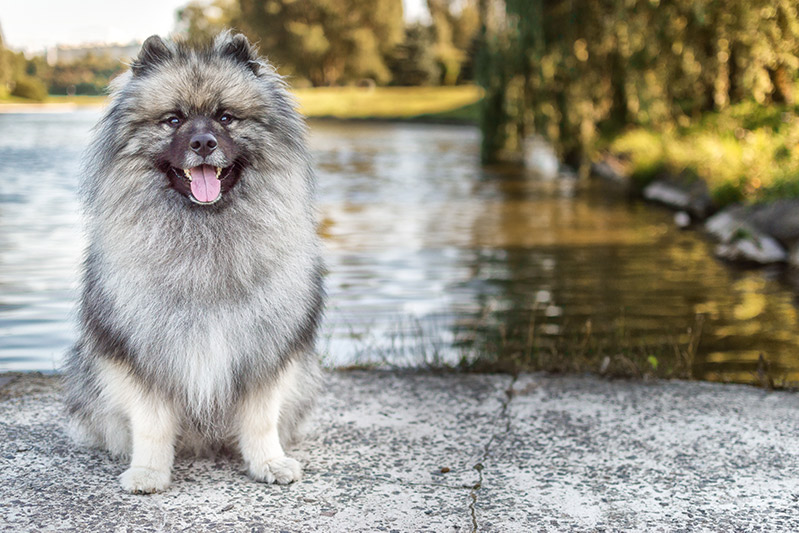
History
The Keeshond breed has been in existence for centuries, having descended from several ancient spitz breeds including the Samoyed, Finnish Spitz, Norwegian Elkhound, German Spitz, Chow Chow and Siberian Husky.
While the origin of the Keeshond is Arctic or possibly sub-Arctic, the breed has been popular in Europe for centuries. In the 13th and 14th centuries, Keeshonds were favoured by farmers because they were assertive watchdogs, guarded the livestock and were safe companions for the family. In the 17th and 18th centuries, they were widely employed as watchdogs on river boats, farms, and barges.
The Kees has long had a close connection with the people of Holland, where it was traditionally used for a variety of jobs, including as a watch dog and for herding, draft work and hunting. Also known as the “Dutch Barge Dog,” the Keeshond was often put to work as a guard dog and a companion on Dutch vessels that sailed the manmade canals of Holland as well as the further reaches of the Rhine River.
Considered as the “people’s dog,” the Keeshond was a mascot of the 18th-century Dutch Patriots Party during its protracted opposition to the royal House of Orange. There is some uncertainty regarding why the Keeshond is so named; either the name refers to a Patriot mascot dog called Kees, or to the nickname of Cornelius de Gyselaar, one of the Patriot leaders who had one of these popular dogs as his constant companion. Regardless, the Keeshond was, and remains to this day, a symbol of Dutch patriotism.
At the beginning of the 20th century, English breeders further developed the breed from imported stock from Holland and Germany. These two breeding stocks and their standards, although closely related, exhibited several variations, including size, head, coat and colour. The English breeders managed, in a remarkably short time, to blend these into the modern-day Keeshond that serves primarily as a companion and watchdog for the family.
The Keeshond’s history in Australia began in 1949 when a Mrs Bourne emigrated from England with her four Keeshonds, who formed the basis of the Australian breeding lines during the 1950s and 1960s.
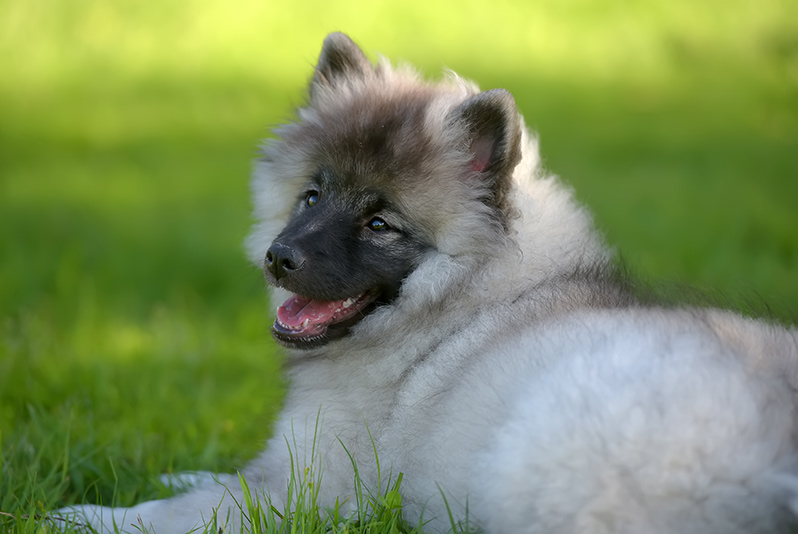
Keeshond Facts!
- The breed is known by many names including the Foxdog, Wolfspitz (in Germany), Dutch Keeshond, Dutch Barge Dog, Chien Loup (in France), Lupini (in Italy), as well as the Laughing Dutchman and the Smiling Dutchman.
- Another nickname is the ‘lazy man’s glamour dog’ because, despite its glamorous appearance, it requires relatively little grooming and trimming.
- The plural of Keeshond is Keeshonden and the second syllable ‘hond’ means ‘dog’ in Dutch. The pronounciation of the name is actually “kayz-hawnd”.
- Because of its political affiliations in Holland in the 18th century, the Keeshond was featured in numerous pictures and cartoons of the time.
- The colours of the Keeshond are always a mix of cream, grey and black. The coats of some dogs may be lighter or darker than others and no two coats are the same. The outer hair always has black tips, which is indicative to the breed.
- The Kees’s expressive eyes and unique facial markings give him the appearance of wearing glasses. This illusion is an essential characteristic of the breed.
Free engraved pet ID tag on sign up3
Customer Satisfaction
21 day cooling off
Easy to use Pet Portal

GapOnly® in vet claims
FURTHER INFORMATION
Keeshond Club of Victoria Inc: http://oz.dogs.net.au/keeshondclubofvictoria/the-keeshond.asp
Petguide.com: https://www.petguide.com/breeds/dog/keeshond/


